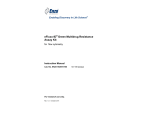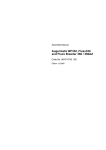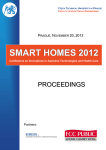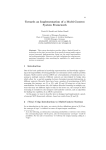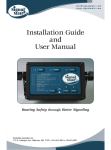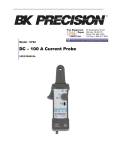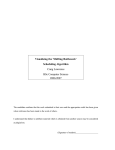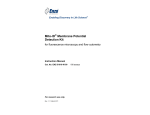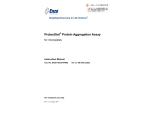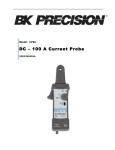Download User Manual-ENZ-51030-K100 - eFluxx
Transcript
Enabling Discovery in Life Science® eFluxx-ID® Gold Multidrug Resistance Assay Kit for flow cytometry Instruction Manual Cat. No. ENZ-51030-K100 For research use only. Rev. 1.0.1 October 2011 for 100 assays Notice to Purchaser The eFluxx-ID® Gold Multidrug Resistance Assay Kit is a member of the CELLestial® product line, reagents and assay kits comprising fluorescent molecular probes that have been extensively benchmarked for live cell analysis applications. CELLestial® reagents and kits are optimal for use in demanding cell analysis applications involving confocal microscopy, flow cytometry, microplate readers and HCS/HTS, where consistency and reproducibility are required. This product is manufactured and sold by ENZO LIFE SCIENCES, INC. for research use only by the end-user in the research market and is not intended for diagnostic or therapeutic use. Purchase does not include any right or license to use, develop or otherwise exploit this product commercially. Any commercial use, development or exploitation of this product or development using this product without the express prior written authorization of ENZO LIFE SCIENCES, INC. is strictly prohibited. Limited Warranty This product is offered under a limited warranty. The product is guaranteed to meet appropriate specifications described in the package insert at the time of shipment. Enzo Life Sciences’ sole obligation is to replace the product to the extent of the purchase price. All claims must be made to Enzo Life Sciences, Inc. within five (5) days of receipt of order. Trademarks and Patents Enzo, CELLestial and eFluxx-ID are trademarks of Enzo Life Sciences, Inc. Several of Enzo’s products and product applications are covered by US and foreign patents and patents pending. Contents I. Introduction ............................................................... 1 II. Reagents Provided and Storage.............................. 2 III. Additional Materials Required ................................. 2 IV. Safety Warnings and Precautions........................... 3 V. Methods and Procedures ......................................... 3 A. REAGENT PREPARATION ................................................... 3 B. ASSAY PROTOCOL ........................................................... 4 C. FLOW CYTOMETRY MEASUREMENTS OF SAMPLES ............ 6 D. CALCULATION OF RESULTS ............................................... 7 VI. Appendices ............................................................... 8 A. SPECTRAL CHARACTERISTICS OF eFLUXX-ID® GOLD DETECTION REAGENT ............................................. 8 B. TECHNICAL HINTS ............................................................ 8 C. COMPENSATION CORRECTION ........................................... 9 D. RESULTS ......................................................................... 9 VII. References .............................................................. 11 VIII. Troubleshooting Guide ......................................... 12 I. Introduction Multidrug resistance relates to resistance of tumor cells to a whole range of chemotherapy drugs with different structures and cellular targets. The phenomenon of multidrug resistance (MDR) is a well-known problem in oncology and thus needs profound consideration in cancer treatment. One of the underlying molecular rationales for MDR is the up-regulation of a family of transmembrane ATP binding cassette (ABC) transporter proteins that present in practically all living organisms. These proteins cause chemotherapy resistance in cancer by actively extruding a wide variety of therapeutic compounds from the malignant cells. The same ABC transporters play an important protective function against toxic compounds in a variety of cells and tissues and at blood-tissue barriers. Enzo Life Sciences’ eFluxx-ID® Gold Multidrug Resistance Assay Kit is designed for functional detection and profiling of multidrug resistant phenotypes in live cells (both suspension and adherent). The kit provides a fast, sensitive and quantitative method for monitoring the function and expression of the three clinically most important multidrug resistance proteins: MDR1 (P-glycoprotein), MRP1/2 and BCRP. The kit includes eFluxx-ID® Gold Detection Reagent as a major component. Being a substrate for three main ABC transporter proteins, this reagent serves as an indicator of these proteins’ activity in the cell. The proprietary AM-ester form of the eFluxx-ID® Gold Detection Reagent is a hydrophobic non-fluorescent compound that readily penetrates the cell membrane and is subsequently hydrolyzed inside of the cells by intracellular esterases. The resulting probe is a hydrophilic fluorescent dye that is trapped within the cell unless actively pumped out by an ABC transporter. The fluorescence signal of the dye generated within the cells thus depends upon the activity of the ABC transporters. The cells with highly active transporters will demonstrate lower fluorescence because of the active efflux of the reagent from the cell. Application of specific inhibitors of the various ABC transporter proteins, included in the kit, allows differentiation between the three common types of pumps. The activity of a particular MDR transporter is defined by the difference between the amount of the dye accumulated in the presence and in the absence of the inhibitors, respectively. The flow cytometry assay is based on determining fluorescence intensities of the tested cells after a short in vitro incubation of cell suspension with the eFluxx-ID® Gold Detection Reagent in the presence or absence of specific ABC transporter inhibitors. The results of the test can be quantified by calculating the MDR activity factor (MAF) values, which allow comparison of multidrug resistance between different samples or cell lines. 1 II. Reagents Provided and Storage All reagents are shipped on dry ice. Upon receipt, the kit should be stored upright and protected from light at ≤-20°C. When stored properly, these reagents are stable for one year upon receipt. Avoid repeated freezing and thawing. Reagents provided in the kit are sufficient for 100 flow cytometry assays using live cells (adherent or in suspension). Reagent Quantity ® eFluxx-ID Gold Detection Reagent 2 vials clear cap MDR1 Inhibitor (Verapamil) white cap 300 nmoles MRP Inhibitor (MK-571) yellow cap 750 nmoles BCRP Inhibitor (Novobiocin) purple cap 1.5 µmoles Propidium Iodide red cap 500 µL III. Additional Materials Required • CO2 incubator (37°C), tissue culture plasticware • Water bath or thermostated dry block for 37°C incubations • Standard flow cytometer equipped with a blue laser (488 nm) • Calibrated, adjustable precision pipetters, preferably with disposable plastic tips • 5 mL round bottom polystyrene tubes for holding cells during staining and assay procedure • Adjustable speed centrifuge with swinging buckets • Anhydrous DMSO • Complete growth medium without Phenol Red (e.g. Dulbecco’s Modified Eagle medium, D-MEM) • PBS (optional, for washing procedures) 2 IV. Safety Warnings and Precautions • This product is for research use only and is not intended for diagnostic purposes. • Some components of this kit may contain hazardous substances. Reagents can be harmful if ingested or absorbed through the skin and may cause irritation to the eyes. They should be treated as possible mutagens, should be handled with care and disposed of properly. • Observe good laboratory practices. Gloves, lab coat, and protective eyewear should always be worn. Never pipet by mouth. Do not eat, drink or smoke in the laboratory areas. All blood components and biological materials should be treated as potentially hazardous and handled as such. They should be disposed of in accordance with established safety procedures. • To avoid photobleaching, perform all manipulations in low light environments or protected from light by other means. V. Methods and Procedures NOTE: PLEASE READ THE ENTIRE PROCEDURE BEFORE STARTING. Allow all reagents to thaw at room temperature before starting with the procedures. Upon thawing, gently hand-mix or vortex the reagents prior to use to ensure a homogenous solution. Briefly centrifuge the vials at the time of first use, as well as for all subsequent uses, to gather the contents at the bottom of the tube. A. REAGENT PREPARATION 1. e-Fluxx-ID® Gold Dye Stock Solution As needed, resuspend the contents of each vial of eFluxx-ID® Gold Detection Reagent (clear cap) in 60 µL anhydrous DMSO. Vortex gently or slowly rotate the tube to dissolve. Store the solution at –20°C. The reconstituted reagent is stable for at least 6 months when stored as recommended. 2. 5 mM Verapamil (MDR1 Inhibitor) Resuspend the MDR1 Inhibitor (Verapamil) (white cap) in 60 µL anhydrous DMSO. Vortex gently or slowly rotate the tube to dissolve. Store the solution at –20°C. The reconstituted reagent is stable for at least 6 months when stored as recommended. 3. 10 mM MK-571 (MRP Inhibitor) Resuspend the MRP Inhibitor (MK-571) (yellow cap) in 75 µL anhydrous DMSO. Vortex gently or slowly rotate the tube to dissolve. Store the solution at –20°C. The reconstituted reagent is stable for at least 6 months when stored as recommended. 4. 50 mM Novobiocin (BCRP Inhibitor) Resuspend the BCRP Inhibitor (Novobiocin) (purple cap) in 30 µL anhydrous DMSO. Vortex gently or slowly rotate the tube to dissolve. Store the solution at –20°C. The reconstituted reagent is stable for 6 months when stored as recommended. 3 B. ASSAY PROTOCOL Cells should be maintained via standard tissue culture practices. Always make sure that cells are healthy and in the log phase of growth before using them for an experiment. IMPORTANT: Because membrane transport mediated by ABC transporters is a complex process that is highly dependent on physiological conditions of cell populations and intracellular ATP status it is important to use living cells in good condition. ATP depletion will decrease the activity of the membrane transporters. 1. Grow cell line of choice in the appropriate medium. Select drugs may interfere with dye efflux. Therefore, the cells should be kept in drug-free medium for at least one week. Anti-microbial agent may be included in the medium, since they do not interfere with multi-drug resistance proteins. Medium should be replaced one day before the assay. Adherent cells should be dislodged from the plates using standard methods and used in suspension for the assay. 2. Count cells using a hemacytometer. For one sample test, four assays should be performed in triplicates (with three different inhibitors and without inhibitor). Approximately 2-5 × 105 cells are required for each assay. Prepare a cell suspension containing 1-2 × 106 cells/mL in pre-warmed (37°C) complete indicator-free medium. 3. For each sample to be assayed, prepare four sets of tubes (in triplicate). Include one tube for the unstained cell control. 4. Immediately prior to use, prepare intermediate dilutions of all 4 inhibitors by mixing appropriate volumes of inhibitor stock solutions (from step V-A) and pre-warmed (37°C) complete indicatorfree medium using the volumes specified in the following table. IMPORTANT: Prepare the dilutions of the inhibitors immediately prior to use as they are susceptible to hydrolysis in aqueous solution. 5. Add 125 µL of inhibitor into separate tubes as indicated in the following table. For control, add 125 µL pre-warmed (37°C) complete indicator-free medium containing 5% DMSO . Table 1. Dilution of Inhibitors Inhibitor Vol. Inhibitor/Conc’n Vol. Medium MDR1 Inhibitor (white cap) 16 µL, 5 mM 1 mL MRP Inhibitor (yellow cap) 20 µL, 10 mM 1 mL BCRP Inhibitor (purple cap) 8 µL, 50 mM 1 mL 4 6. Add 250 μL of cell suspension into each tube (see Table 2). Gently mix the contents of each tube by pipetting (avoid introducing bubbles) and incubate all the tubes at 37°C for 5 min. Table 2. Assay Reagent Volumes Tube Nos. Vol. Dilute Inhibitor (from step B-4) Vol. Cell Suspension Vol. Dilute eFluxx-ID™ Gold Dye 1-3 125 µL MDR1 Inhibitor 250 µL 125 µL 4-6 125 µL MRP Inhibitor 250 µL 125 µL 7-9 125 µL BCRP Inhibitor 250 µL 125 µL 10-12 (Stained Controls) 125 µL Medium/DMSO 250 µL 125 µL 13 (Unstained Control) 250 µL Medium/DMSO 250 µL — 7. Dilute the eFluxx-ID® Gold dye stock solution (from step V-A1) by combining 16 μL of the stock solution and 2 mL of pre-warmed (37°C), complete indicator-free medium. Mix well by vortexing the tube gently. IMPORTANT: Dilution of the eFluxx-ID® Gold dye stock solution should be done just prior to use as it is susceptible to hydrolysis in aqueous solution. 8. Begin the assay by adding 125 μL of the freshly diluted eFluxx-ID™ Gold dye solution (from step B-7) into each tube (except the tube labeled for unstained cells). Gently mix cell suspensions by pipetting (avoid introducing bubbles) and incubate all the tubes at 37°C for 30 min. 9. After 25 min of incubation, 5 μL of the provided stock solution of Propidium Iodide (red cap) can be added to each tube for cell viability monitoring. 10. Perform flow cytometry measurements immediately after reaction (proceed to section C, page 6). 11. If immediate measurements are not possible, or if the number of samples is over 30, stop the reaction by rapid centrifugation (1 min, 200 x g). Discard the supernatant and re-suspend the cells in 0.5 mL of ice cold complete indicator-free medium or PBS containing dilute Propidium Iodide (50 μL of the provided stock solution of Propidium Iodide in 5 mL of medium or PBS). These samples can be stored at 4°C for several hours. 5 C. FLOW CYTOMETRY MEASUREMENT OF SAMPLES The cellular orange fluorescence signal of e-Fluxx-ID® Gold Detection Reagent should be measured using a flow cytometer in all tubes in the living (PI negative) cell population with identical equipment settings. 1. Within the flow cytometry software, set an FSC-SSC dot plot, an FSC-FL3 dot plot, and an FL2 histogram plot. For better separation of the different cell populations, using a log scale is recommended for the fluorescence channels (FL2 and FL3). 2. Run unstained cells and adjust both forward and side scatter PMT amplifications to display all the cell subsets on the FSC-SSC dot plot. 3. Set a gate (R1) on the FSC-SSC dot plot, selecting the cell population of interest but excluding cell debris (Figure 1A). Display the cells selected by the R1 gate in an FSC-FL3 dot plot format. IMPORTANT: Compensation correction may be needed to avoid overlap between orange and red fluorescent signals (see Appendix C) RECOMMENDED CONTROLS FOR COMPENSATION CORRECTION : • Unstained untreated cells • Inhibitor (verapamil is recommended) treated cells stained with eFluxx-ID® Gold Detection Reagent (“Orange” cells) • Untreated cells stained with Propidium Iodide only (”Red” cells) 4. Set a second gate (R2) in the FSC-FL3 window to exclude PI-positive cells from analysis (Figure 1B). To avoid errors originated from the spillover of orange fluorescence of the eFluxx-ID® Gold Detection Reagent, set the R2 border as high as possible. Display R2-gated events in the FL2 histogram plot format. B A C Figure 1. Flow cytometry measurements of the samples. Setting the parameters: Gate out the debris (Panel A), gate PI-negative events (Panel B), and set PMTs for the FL2 fluorescence channel (Panel C) 6 5. Run tube no. 1 and adjust the PMT amplification for FL2 so that the peak of the histogram is located between the second and third decades on the FL2 histogram channel (Figure 1C). 6. Save settings in a properly designated template file (e.g. “MDR settings”). We recommend the use of the same or similar settings whenever possible. You may need to readjust slightly the PMT amplifications and /or the gate locations after an initial test run. D. CALCULATION OF RESULTS 1. Calculate the mean FL2 fluorescence intensity (MFI) values for each triplicate set of measurements: FMDR1 from tubes no. 1, 2 and 3 FMRP from tubes no. 4, 5 and 6 FBCRP from tubes no. 7, 8 and 9 F0 from tubes no. 10, 11 and 12 2. If differences between parallel sets of measurements are <10%, use all three values to calculate the mean. If one value is extreme (a difference of >10%), disregard the unreliable data, and calculate the mean from the other two. If all MFI values differ by >10%, redo the analysis (see the troubleshooting guide). 3. Calculate the multidrug resistance activity factor (MAF) for each transporter, using the following formulas: MAFMDR1 = 100 × (FMDR1 - F0)/FMDR1 MAFMRP = 100 × (FMRP - F0)/FMRP MAFBCRP = 100 × (FBCRP - F0)/FBCRP In extreme cases (without MDR1, MRP or BCRP activity), the MFI values corresponding to inhibitor-treated cells can be smaller than the MFI value of non-inhibitor-treated cells. In such cases, corresponding MAF values should be regarded as zero. 7 VI. APPENDICES Control % A. SPECTRAL CHARACTERISTICS OF eFLUXX-ID® GOLD DETECTION REAGENT Figure 2. The absorption and emission peaks of e-Fluxx-ID Gold detection dye are 530 nm and 555 nm, respectively. It can be well excited with an argon ion laser at 488 nm, and detected in the FL2 channel of most bench flow cytometers. Wavelength, nm B. TECHNICAL HINTS 1. Multidrug resistance assay is a functional test that requires living cells in good condition. The cells should always be kept in the appropriate incubation buffer, containing all the essential components. Do not use fixatives, azide or other preservatives. 2. Shear stress can be harmful to the cells. Do not vortex cell suspensions. Always mix them with gentle pipetting. Avoid forming excessive bubbles. 3. Cells in suspension sediment very rapidly and have to be mixed prior to any procedure (counting, aliquotting, running the samples on a flow cytometer). Mix cells by gentle pipetting and forming excessive bubbles. 4. Cell suspensions at the recommended concentrations will normally result in 100-300 events/sec flow rate. Keeping the flow rate below 600 events/sec is recommended. 8 C. COMPENSATION CORRECTION Fluorescence of eFluxx-ID® Gold Detection reagent will be detected in the FL2 channel. Dead (non-viable) cells will be detected in the FL3 channel. To avoid overlap between orange and red fluorescent signals, the following compensation procedure should be performed. 1. Run the unstained untreated sample first. Generate a FSC versus SSC dot plot and gate out cell debris. 2. Generate a log FL2 (X-axis) versus a log FL3 (Y-axis) dot plot. Adjust the PMT voltages for both channels so that the signals from the unstained cells falls within the first log decade scale of FL2 and FL3 axes. 3. Run single stained “Red” positive control and adjust the FL2 - %FL3 compensation until the orange fluorescence signal falls into the first decade of the log FL2 scale. 4. Repeat the compensation procedure with the “Orange” single stained positive control and adjust the FL3 - %FL2 compensation until the red fluorescence signal falls into the first decade of the log FL3 scale. Note: It is important to use the brightest positive single stained samples (inhibitor-treated) for proper compensation correction to allow negative cells to be distinguished from slightly positive (dim) cells. D. RESULTS 1. The theoretical range of the MAF values are between 0 and 100. Studies comparing MAF values with clinical response to a chemotherapeutic treatment suggest that a specimen with an MAF value of <20 can be regarded as multidrug resistance negative, while MAF values >25 are indicative of multidrug resistance positive specimens. 2. In drug-selected cell lines exhibiting extremely high expression levels of ABC transporter proteins, the MAF values can be as high as 95-98. 3. Typical results of the assay are presented in Figure 3 on page 10. 9 Figure 3. Typical results of the multidrug resistance assay. CHO K1 cells were incubated with eFluxx-ID Gold Detection Reagent with and without specific inhibitors according to the kit protocol. Resulting fluorescence was measured using flow cytometry. Tinted histograms show fluorescence of inhibitor-treated samples and non-tinted histograms show fluorescence of untreated cells. The difference in fluorescence is indicative of a corresponding protein activity. The numbers in the upper left corners are MAF scores (multidrug resistance activity factors)—quantitative characteristics of multidrug resistance. 4. The eFluxx-ID® Gold Multidrug Resistance Assay Kit has been validated in various cell lines expressing multidrug resistance proteins that are summarized in Table 3. Table 3. Cell Lines Expressing Multidrug Resistance Proteins Cell Line (Reference) MDR1 MRP BCRP CHO K1 (6) + + + HeLa (6) - - - A549 (7) - + + HCT-8 (8, 9) + + - Hep-G2 (10) + - - Jurkat (11) - + - U-2 OS (12) + + + U-2 OS RFP (12) + + + 10 VII. References 1. Homolya L, Hollo Z, Germann UA, Pastan I, Gottesman MM and Sarkadi B. (1993) Fluorescent cellular indicators are extruded by the multidrug resistance protein. J Biol Chem 268: 21493-21496. 2. Feller N, Kuiper CM, Lankelma J, Ruhdal JK, Scheper RJ, Pinedo HM, Broxterman HJ. (1995) Functional detection of MDR1/P170 and MRP/P190-mediated multidrug resistance in tumour cells by flow cytometry. Br J Cancer 72: 543-549. 3. Broxterman HJ, Lankelma J and Pinedo HM. (1996) How to probe clinical tumour samples for P-glycoprotein and multidrug resistanceassociated protein. Eur J Cancer 32A: 1024-1033. 4. Litman T, Druley TE, Stein WD and Bates S. (2001) From MDR to MXR: new understanding of multidrug resistance systems, their properties and clinical significance. Cell Mol Life Sci 58: 931-959. 5. Beck WT, Grogan TM, Willman CL et al. (1996) Methods to detect p-glycoprotein-associated multidrug resistance in patients’ tumours: Consensus recommendations. Cancer Res 56:3010-3020. 6. Gupta RS. (1988) Intrinsic multidrug resistance phenotype of chinese hamster (rodent) cells in comparison to human cells. Biochem Biophys Res Commun 153: 598-605. 7. McCollum AK, TenEyck CJ, Stensgard B, et al. (2008) P-glycoprotein-mediated resistance to Hsp90-directed therapy is eclipsed by the heat shock response. Cancer Res 68:7419-7427. 8. Collington GK, Hunter J, Allen CN, Simmons NL, Hirst BH. (1992) Polarized efflux of 2',7'-bis(2-carboxyethyl)-5(6)-carboxyfluorescein from cultured epithelial cell monolayers. Biochem Pharmacol.; 44: 417-24. 9. Hunter J, Hirst BH, Simmons NL. (1991) Epithelial secretion of vinblastine by human intestinal adenocarcinoma cell (HCT-8 and T84) layers expressing P-glycoprotein. Br J Cancer 64: 437-44. 10. Roelofsen H, Vos TA, Schippers IJ, et al. (1997) Increased levels of the multidrug resistance protein in lateral membranes of proliferating hepatocyte-derived cells. Gastroenterology 112: 511-21. 11. Hammond CL, Marchan R, Krance SM, and Ballatori N. Glutathione Export during Apoptosis Requires Functional Multidrug ResistanceAssociated Proteins. J Biol Chem 282: 14337-14347. 12. Bodey B, Taylor CR, Siegel SE and Kaiser HE. (1995) Immunocytochemical observation of multidrug resistance (MDR) p170 glycoprotein expression in human osteosarcoma cells. The clinical significance of MDR protein overexpression. Anticancer Res. 15 (6B): 2461-2468. 11 VIII. Troubleshooting Guide Problem Cells do not exhibit fluorescence after incubation with the detection reagent. Potential Cause Cell viability is low. Very low concentration of ® the eFluxx-ID Gold Detection Reagent Suggestion Cells should be in log growth phase. Cell samples can not be kept longer than 6 hours before the assay. Do not use fixatives, azides or other preservatives. Avoid shear stress, do not vortex, and avoid bubbling . Check the concentration of the reagent. Cells do not express any MDR1, MRP1/2 or BCRP. Use a positive control cell type expressing corresponding ABC transporter. Quality of the reagents is compromised. Check storage, stability and freshness of the reconstituted reagents. Lower than expected fluorescence increases after incubation with inhibitor. Overcompensation of the FL2 signal Change the values of compensation correction using single stained positive samples. Follow the recommendations in Appendix C. Percentage of dead (PI positive) cells is too high. Wrong compensation correction. Change the values of compensation correction using single stained positive samples. Follow the recommendations in Appendix C. There are differences in MFI (mean fluorescence intensity) values between cell lines. Detection reagent accumulation may be influenced by cell size, endogenous esterase activity, etc. Using the inhibitors and calculating the MAF values eliminate these differences. Inadequate incubation condition. Always use a water bath (not incubator). Ensure temperature of water bath is 37°C. Cell viability is low. Cells should be in log growth phase. Cell samples cannot be kept longer than 6 hours before the assay. Do not use fixatives, azides or other preservatives. Avoid shear stress, do not vortex, and avoid bubbling. Fluorescence does not increase after incubation with inhibitor Inconsistent fluorescence shift using the same cells (irreproducible results) 12 www.enzolifesciences.com Enabling Discovery in Life Science® NORTH/SOUTH AMERICA GERMANY UK & IRELAND ENZO LIFE SCIENCES, INC. 10 Executive Boulevard Farmingdale, NY 11735-4710 USA T 1-800-942-0430/(631) 694-7070 F (631) 694-7501 E [email protected] www.enzolifesciences.com ENZO LIFE SCIENCES GMBH Marie-Curie-Strasse 8 DE-79539 Lörrach Germany T +49/0 7621 5500 526 Toll Free 0800 664 9518 F +49/0 7621 5500 527 E [email protected] www.enzolifesciences.com ENZO LIFE SCIENCES (UK) LTD. Palatine House Matford Court Exeter EX2 8NL UK T 0845 601 1488 (UK customers) T +44/0 1392 825900 (from overseas) F +44/0 1392 825910 E [email protected] www.enzolifesciences.com EUROPE & ASIA BENELUX FRANCE ENZO LIFE SCIENCES (ELS) AG Industriestrasse 17, Postfach CH-4415 Lausen Switzerland T +41/0 61 926 89 89 F +41/0 61 926 89 79 E [email protected] www.enzolifesciences.com ENZO LIFE SCIENCES BVBA Frankrijklei 33 - Bus 31 BE-2000 Antwerpen Belgium T +32/0 3 466 04 20 F +33/0 437 484 239 E [email protected] www.enzolifesciences.com ENZO LIFE SCIENCES (ELS) AG Branch Office Lyon 13, Avenue Albert Einstein FR -69100 Villeurbanne France T +33 472 440 655 F +33 437 484 239 E [email protected] www.enzolifesciences.com
















